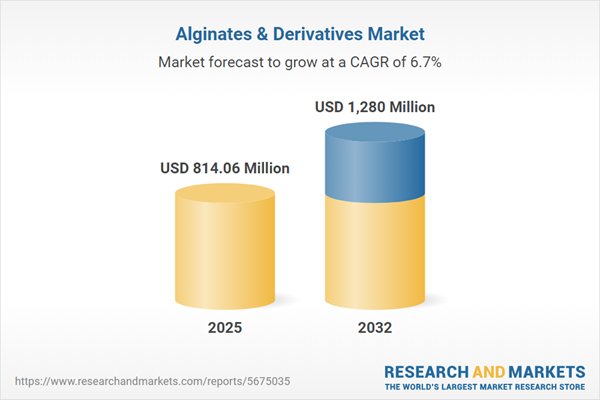Speak directly to the analyst to clarify any post sales queries you may have.
The alginates and derivatives market is experiencing rapid change driven by sustainability requirements, application expansion, and evolving trade policies. Senior executives seeking clarity and actionable guidance will find rigorous analysis and strategic insight throughout this market research report.
Market Snapshot: Alginates & Derivatives Market Size and Growth
The Alginates & Derivatives Market grew from USD 762.49 million in 2024 to USD 814.06 million in 2025. It is expected to continue growing at a CAGR of 6.74%, reaching USD 1.28 billion by 2032. The market’s development is fueled by demand from food, pharmaceutical, and personal care sectors, and by global trends favoring bio-based, multifunctional additives.
Scope & Segmentation
This report delivers in-depth coverage of the alginates and derivatives marketplace across pivotal business segments, technology paradigms, and key geographies.
- Type: Calcium alginate, Potassium alginate, Propylene glycol alginate, Sodium alginate
- Application: Agriculture & animal feed, Food & beverage (including bakery & confectionery, beverages, dairy & frozen desserts), Paper & packaging, Personal care & cosmetics (hair care, oral care, skin care), Pharmaceuticals & healthcare (dental, drug delivery, wound care & dressings), Textile
- Form: Flakes, Fluid, Granules, Powder
- Source: Bacterial, Brown seaweed
- Molecular Weight: High, Low, Medium
- Regional Coverage: Americas (United States, Canada, Mexico, Brazil, Argentina, Chile, Colombia, Peru), Europe, Middle East & Africa (including United Kingdom, Germany, France, Russia, Italy, Spain, Netherlands, Sweden, Poland, Switzerland, United Arab Emirates, Saudi Arabia, Qatar, Turkey, Israel, South Africa, Nigeria, Egypt, Kenya), Asia-Pacific (China, India, Japan, Australia, South Korea, Indonesia, Thailand, Malaysia, Singapore, Taiwan)
- Leading Companies: FMC Corporation, Cargill, Incorporated, Algaia SAS, Qingdao Bright Moon Seaweed Group Co., Ltd., Weishardt S.A., Kimica Corporation, Zhenjiang Tianrun Biotech Co., Ltd., International Flavors & Fragrances Inc., Kerry Group plc, Ingredion Incorporated
Key Takeaways: Strategic Insights for Decision-Makers
- Alginates, derived primarily from brown seaweed and bacterial sources, have achieved essential status in formulations requiring gelling, thickening, or stabilization, serving industries ranging from food to advanced pharmaceuticals.
- Emerging extraction innovations, notably in enzymatic and microbial fermentation, are improving sustainability profiles while elevating purity levels, which is especially relevant for drug delivery and clean-label trends.
- Rapidly evolving regulatory environments and sustainability requirements are prompting manufacturers to invest in traceability, microbial safety, and environmentally sound sourcing practices.
- Market segmentation reveals growing interest in high-performance forms and specialty molecular weights to support applications in wound care, encapsulation, plant-based foods, and biodegradable packaging.
- Major industry players are pursuing product portfolio diversification, upstream integration via feedstock partnerships and acquisitions, and cross-sector collaborations to strengthen competitive positioning.
- Regional variations create both challenges and new opportunities; North American and European manufacturers are adapting swiftly to supply chain shifts, while Asia-Pacific remains the driving force in raw material supply and processing innovation.
Tariff Impact: Navigating U.S. Policy Changes
Revised United States tariffs in 2025 are driving notable supply chain realignment across the alginates sector. Manufacturers are seeking local or tariff-exempt sources and building new collaborations with domestic seaweed cultivators or microbial fermentation producers, which reshapes production and cost structures. Larger players with integrated supply chains are managing added complexities more effectively, while smaller firms face pronounced margin pressures, especially in highly competitive food additive segments.
Methodology & Data Sources
Our research process combines in-depth primary interviews with industry leaders and technical specialists, alongside exhaustive secondary reviews of public filings, regulatory documents, trade association reports, and scientific publications. Rigorous data triangulation and scenario validation ensure that the insights and projections are accurate, tested, and unbiased.
Why This Report Matters
- Enables C-suite leaders to understand dynamic market shifts and align capital allocation with true growth drivers.
- Offers a comprehensive analysis of competitive strategies, regional shifts, and emerging opportunities in the alginates industry.
- Distills complex technological and regulatory changes into actionable insights for informed strategic decision-making.
Conclusion
This report guides senior leaders in navigating policy, supply chain, and innovation challenges within the alginates and derivatives market. Stakeholders can leverage segmentation insights and trend analysis to support resilient growth strategies and capture value in this evolving landscape.
Additional Product Information:
- Purchase of this report includes 1 year online access with quarterly updates.
- This report can be updated on request. Please contact our Customer Experience team using the Ask a Question widget on our website.
Table of Contents
3. Executive Summary
4. Market Overview
7. Cumulative Impact of Artificial Intelligence 2025
Companies Mentioned
The companies profiled in this Alginates & Derivatives market report include:- FMC Corporation
- Cargill, Incorporated
- Algaia SAS
- Qingdao Bright Moon Seaweed Group Co., Ltd.
- Weishardt S.A.
- Kimica Corporation
- Zhenjiang Tianrun Biotech Co., Ltd.
- International Flavors & Fragrances Inc.
- Kerry Group plc
- Ingredion Incorporated
Table Information
| Report Attribute | Details |
|---|---|
| No. of Pages | 199 |
| Published | October 2025 |
| Forecast Period | 2025 - 2032 |
| Estimated Market Value ( USD | $ 814.06 Million |
| Forecasted Market Value ( USD | $ 1280 Million |
| Compound Annual Growth Rate | 6.7% |
| Regions Covered | Global |
| No. of Companies Mentioned | 11 |









